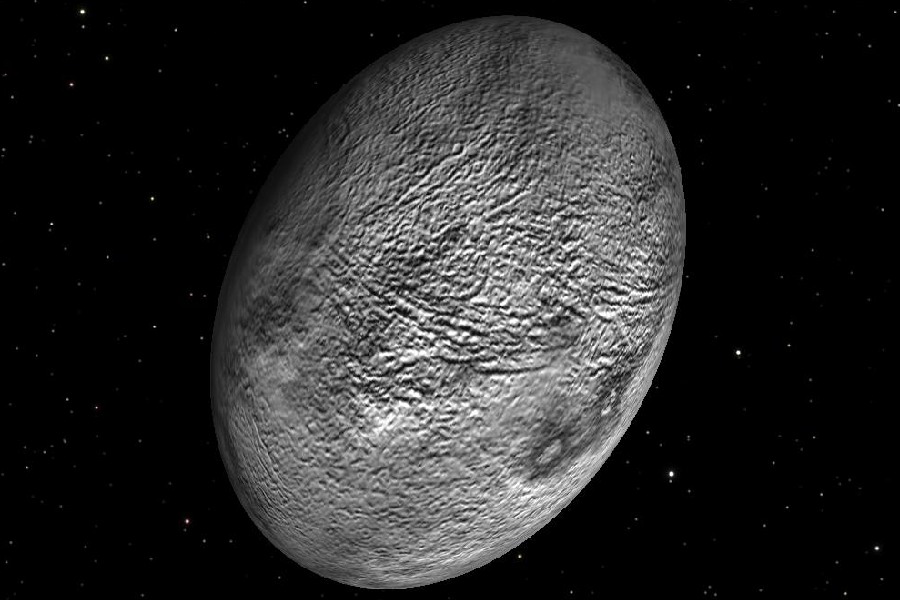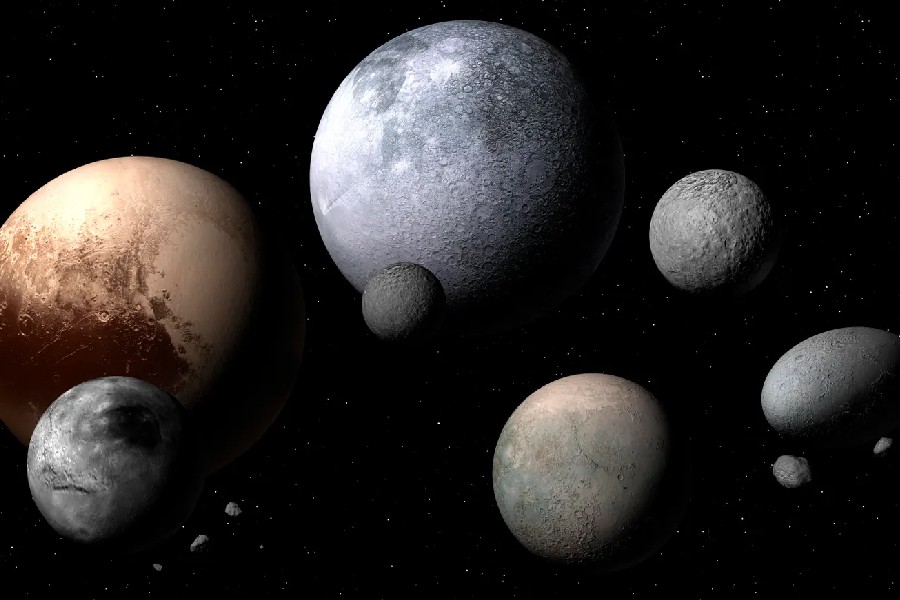Beyond the orbit of Neptune, a mysterious icy world lurks. This distant dwarf planet, named Haumea, travels our Solar System’s outer limits within the enigmatic Kuiper Belt. With its elongated shape and rapid rotation, Haumea stands out as one of the most unusual dwarf planets.
Yet this unique celestial body eluded detection for over two centuries after the discovery of another dwarf planet, Ceres. Only in the last few decades have advances in observational technology enabled the discovery of Haumea and its fellow Kuiper Belt denizens.
When exactly was this intriguing, egg-shaped dwarf planet finally uncovered? What crucial developments in telescopes and techniques finally allowed Haumea to be pulled from obscurity? Read on to learn when was Haumea discovered and what’s its story.

When Was Haumea Discovered?
Haumea, a dwarf planet located in the outer regions of our Solar System, was officially discovered on December 28, 2004. The discovery was announced by a team of astronomers led by Mike Brown at the Palomar Observatory in California.
Initially designated as 2003 EL61, Haumea was later given its official name in 2008. This elongated and fast-spinning dwarf planet, residing in the Kuiper Belt, adds to the diversity of celestial bodies beyond the orbit of Neptune.
Its discovery and subsequent observations have contributed to our understanding of the dynamic and varied nature of objects in the outer reaches of the Solar System.
Discovery Timeline of Haumea
Prelude to discovery
In the early 2000s, astronomers were discovering new icy bodies beyond Neptune at a rapid pace. This motivated searches for even more distant Kuiper Belt objects.
Teams at observatories like Palomar began systematically scanning the sky for faint, moving points of light.
Palomar Observatory in California is home to the Samuel Oschin Telescope. This instrument’s wide field of view allowed efficient surveys searching for Kuiper Belt objects. Astronomers Mike Brown, Chad Trujillo, and David Rabinowitz led efforts at Palomar.
December 28, 2004
On December 28, 2004, images captured by the Samuel Oschin Telescope at Palomar Observatory revealed a slow-moving object. Additional observations confirmed the discovery of a new Kuiper Belt object. It received the provisional designation 2003 EL61
Over the next few nights, Brown, Trujillo, and Rabinowitz tracked 2003 EL61 across the sky and collected more data. Analysis hinted at an unusually large and elongated body orbiting at an extreme distance. 2003 EL61 was an exciting find.
Official naming in 2008
In September 2008, 2003 EL61 finally received an official name – Haumea, after the Hawaiian goddess of fertility. This choice fits the icy dwarf planet’s discovery by a Californian team. However, it sparked some initial controversy.
Some criticized Haumea’s name for not conforming to IAU naming conventions. But further deliberations led to international acceptance of the appropriate mythological designation. Haumea was granted recognition as the fifth designated dwarf planet.
Size and Distance
Elongated shape and composition
Haumea has an elongated, ellipsoidal shape reminiscent of a rugby ball or football. Its dimensions are approximately 1240 x 930x 620 miles (2000 x 930 x 620 kilometers).
This makes Haumea’s shape more extreme than any other known dwarf planet. No other object in the Kuiper Belt exhibits such an irregular, elongated form. The dwarf planet’s odd dimensions make it a true outlier.
When it comes to the composition, Haumea consists almost entirely of frozen water ice. Trace amounts of rock are also present. The rigid structure of crystalline ice under Haumea’s gravity causes it to maintain this elongated, flattened form unlike spherical worlds.
Models indicate the ice that comprises Haumea is some of the purest found in the outer Solar System. The lack of reshaping collisions has kept the dwarf planet’s icy body in this unique shape.
Orbital dynamics
At its farthest, Haumea orbits nearly 51 astronomical units from the Sun. One AU is the distance between Earth and Sun. This great distance places Haumea firmly among the scattered disc objects in the outermost Kuiper Belt.
Unlike most Kuiper Belt denizens, Haumea has a very elliptical orbit tilted substantially relative to the ecliptic plane. These dynamics give Haumea an orbital period of 285 years. The dwarf planet also completes a lightning-fast rotation every four hours, likely due to a past collision.

Discovery Team
Faces behind the discovery
The team that discovered Haumea consisted of astronomers Mike Brown, Chad Trujillo, and David Rabinowitz. All three were researchers at Caltech conducting surveys using Palomar Observatory’s Samuel Oschin Telescope.
Brown and Rabinowitz were experienced Kuiper Belt researchers, having already discovered several large trans-Neptunian objects before detecting Haumea. Trujillo specialized in observational astronomy and brought valuable technical expertise.
Technological advancements
- Wide-field surveys – The large 1.2-meter mirror and wide field of view of the Oschin Telescope allowed efficient searches covering large swaths of sky. This enabled the discovery team to systematically pinpoint Haumea during routine KBO surveys.
- Digital imaging – Advanced CCD imaging technology coupled with automated analysis software enabled detection of Haumea’s tiny motion against background stars. Digital sensors produced rapid, high-resolution imaging critical to identifying this faint, distant object.
- Remote observation – Telescopic surveys at Palomar were capable of robotic remote operation. This allowed constant monitoring of the night sky without an observer on-site. Around-the-clock robotic observation led to Haumea’s discovery during routine scans.
Astronomical Objects in the Kuiper Belt
Haumea’s Kuiper Belt residence
Haumea orbits the Sun in the Kuiper Belt beyond Neptune. Its average distance from the Sun is about 43 times farther than Earth’s orbit. At this distance, Haumea takes 285 years to complete one revolution around the Sun.
Haumea’s highly elliptical orbit is tilted relative to the ecliptic plane. This inclination sets Haumea apart from other Kuiper Belt objects.
Regarding Haumea’s neighbors – this dwarf planet inhabits the inner edges of the classical Kuiper Belt. This region overlaps with Pluto and many other dwarf planets. Haumea’s fellow Kuiper Belt denizens include Makemake, Quaoar, Orcus, and Salacia among others.
These worlds all orbit in the same distant realm beyond Neptune. However, Haumea stands out due to its elongated shape and rapid rotation.
Kuiper belt significance
The Kuiper Belt contains remnants from the early Solar System. Studying Kuiper Belt objects provides insights into the primordial disk of dust and gas that formed the planets billions of years ago.
These icy bodies are essentially frozen in time, preserving clues about the Solar System’s origins. Analyzing their compositions and dynamics sheds light on the processes that shaped the layout of our cosmic neighborhood.
Several missions continue to visit and study the Kuiper Belt. In 2015, the New Horizons spacecraft flew by Pluto and revealed its complex geology.
More recently in 2019, New Horizons performed history’s first flyby of a Kuiper Belt object, studying the peanut-shaped asteroid Arrokoth.
Meanwhile, multiple ground-based surveys keep discovering new Kuiper Belt objects every year. As we gather more data, a clearer picture emerges of how the Solar System formed and evolved. The Kuiper Belt presents an exciting scientific frontier filled with revelations about our cosmic origins.
Conclusion
Our exploration of Haumea has illuminated the distant frontier of the Kuiper Belt and the intriguing objects found there. This unusual dwarf planet, with its dramatic elongated shape and rapid rotation, represents just one of many relics from our solar system’s early days.
When was Haumea discovered? The discovery of Haumea in 2004 expanded our cosmic perspective and offered new insights into the formation of planets. These relics are awaiting further study.
This frozen world was revealed little more than a decade ago thanks to the ongoing efforts of dedicated astronomers and the advanced technologies at their disposal.
As Kuiper Belt research continues, we hope this article has helped you better understand the significance of Haumea’s discovery and appreciation for the fascinating denizens of the outer Solar System.
